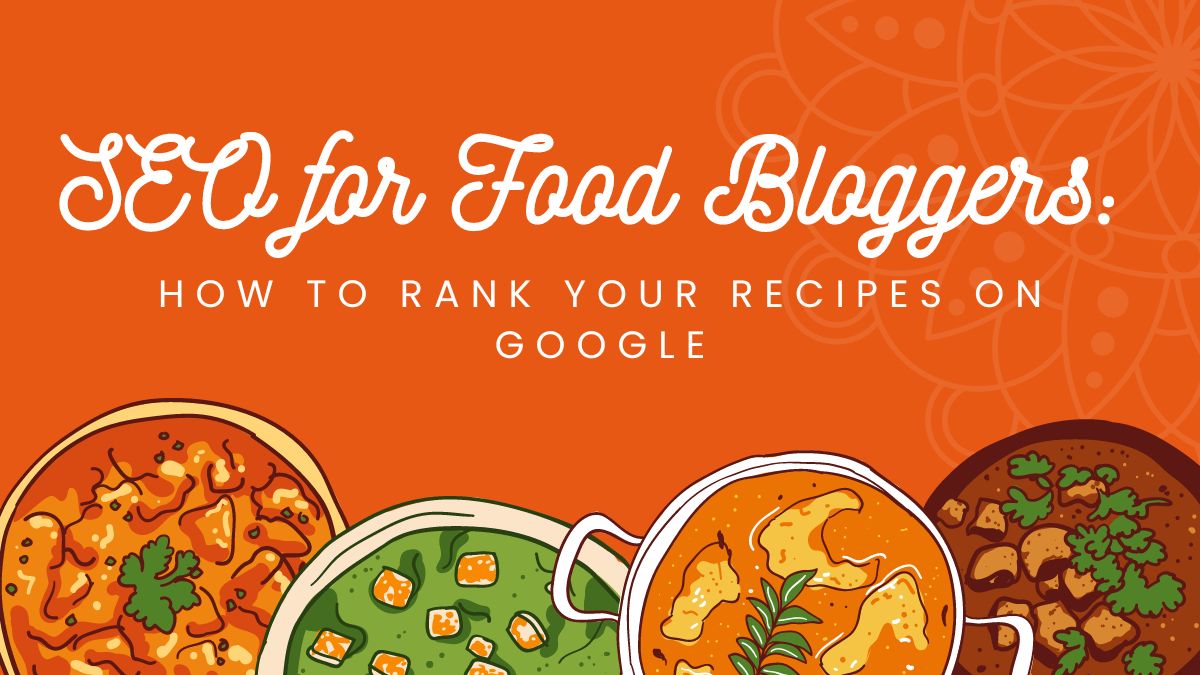
Food blogging is vibrant and competitive. Visual appeal and mouth-watering descriptions are just part of the game. To reach more people with your delicious recipes, you must master SEO. Good SEO practices can greatly boost your blog’s visibility on Google. They bring more traffic and increase your chances of turning visitors into followers. This guide is comprehensive. It will explore the best SEO strategies for food bloggers. They are tailored to help you rank your recipes on Google.
1. Conduct Thorough Keyword Research
Importance of Keyword Research
Keyword research is the backbone of SEO. Knowing what your audience is searching for lets you tailor your content to meet their needs. This means finding words related to your recipes. They should be about cooking and tips for food.
Tools for Keyword Research
Use keyword research tools. These include Google Keyword Planner, Ahrefs, SEMrush, and Ubersuggest. They are for finding relevant keywords. Look for both high-volume and long-tail keywords. Long-tail keywords have lower search volumes. But, they often attract highly targeted traffic with clear intent.
Incorporate Keywords Naturally
Once you’ve identified your target keywords, integrate them naturally into your blog posts. Key areas to focus on include:
- Recipe Titles: Ensure your primary keyword is included in the recipe title.
- Meta Descriptions: Write compelling meta descriptions that include your main keyword and encourage clicks.
- Headers and Subheaders: Use keywords in H1, H2, and H3 tags to improve readability and SEO.
- Content and Alt Text: Use keywords in your recipe content and image alt text without keyword stuffing.
2. Craft Engaging and SEO-Friendly Recipe Titles
Importance of Recipe Titles
Your recipe title is one of the first things both users and search engines see. It should be descriptive, engaging, and include your primary keyword. A well-crafted title can significantly impact click-through rates (CTR) and search rankings.
Tips for Writing Recipe Titles
- Be Specific: Use specific descriptions to make your recipe stand out (e.g., “Vegan Chocolate Chip Cookies” instead of just “Cookies”).
- Include Keywords: Ensure your primary keyword is naturally incorporated into the title.
- Add a Unique Twist: Highlight a unique ingredient or technique to capture interest (e.g., “Vegan Chocolate Chip Cookies with Avocado”).
3. Optimize Your Recipe Content
Write Detailed and Clear Instructions
Search engines favor content that is detailed and provides value to users. Ensure your recipe instructions are clear, detailed, and easy to follow. Break the process into steps. Use bullet points or numbers for readability.
Use Structured Data Markup
Structured data markup, also called schema markup, helps search engines understand your recipe. It makes them display rich snippets in search results. Use Recipe schema to mark up your recipes, including key elements such as:
- Ingredients: List all the ingredients required for the recipe.
- Instructions: Provide step-by-step cooking instructions.
- Cooking Time: Specify preparation and cooking times.
- Nutritional Information: Include details like calorie count and nutritional content.
- Reviews and Ratings: Allow users to leave reviews and ratings for your recipes.
Adding structured data can improve your search listings. It can add rich snippets, which make listings more attractive and informative. This can lead to higher CTRs.
4. Optimize Images for SEO
Importance of Image Optimization
High-quality images are crucial for food blogs. But, they also need to be good for search engines. Properly optimized images can improve page load times, user experience, and search rankings.
Best Practices for Image Optimization
- Descriptive File Names: Rename image files to include relevant keywords before uploading them.
- Alt Text: Write descriptive alt text for each image, incorporating keywords to help search engines understand the content.
- File Size and Format: Compress images to reduce file size without sacrificing quality. Use formats like JPEG for photos and PNG for graphics with transparency.
- Responsive Images: Ensure images are responsive and display correctly on all devices.
5. Improve Page Load Speed
Impact of Load Speed on SEO and User Experience
Page load speed is a critical factor for both SEO and user experience. Slow-loading pages can cause more bounces. They also lead to lower search rankings and frustrate visitors.
Tips to Enhance Page Load Speed
- Optimize Images: Compress and resize images appropriately.
- Leverage Browser Caching: Enable caching to store some files locally on users’ browsers, reducing load times for repeat visitors.
- Minimize HTTP Requests: Reduce the number of elements on your page to minimize HTTP requests.
- Use a Content Delivery Network (CDN): A CDN can distribute your content across multiple servers worldwide, speeding up load times for users regardless of their location.
- Minify CSS, JavaScript, and HTML: Remove unnecessary code to streamline your website’s performance.
6. Enhance User Experience (UX)
User Experience and SEO
A positive user experience can indirectly impact your SEO. Search engines consider metrics. These include bounce rate, time on site, and pages per session. They use them when ranking pages.
Tips to Improve UX
- Mobile Optimization: Ensure your blog is fully responsive and optimized for mobile devices.
- Easy Navigation: Use clear and intuitive navigation to help users find recipes quickly.
- Clean Design: Avoid clutter and focus on a clean, visually appealing design.
- Clear Calls to Action (CTAs): Use prominent and persuasive CTAs to guide users toward actions like subscribing to your newsletter or leaving a comment.
7. Build High-Quality Backlinks
Importance of Backlinks
Backlinks are one of the most important ranking factors for SEO. Good backlinks come from quality sites. They signal to search engines that your content is valuable and trustworthy.
Strategies for Building Backlinks
- Guest Blogging: Write guest posts for other food blogs or websites in your niche. Include links back to your recipes.
- Collaborations and Partnerships: Partner with other bloggers or influencers for recipe collaborations or round-up posts.
- Social Media and Networking: Share your recipes on social media platforms and engage with your audience to increase the likelihood of others linking to your content.
- Submit to Recipe Directories: Submit your recipes to popular recipe directories and aggregators.
8. Encourage and Display User Engagement
Importance of User Engagement
Comments, social shares, and time on page are user engagement signals. They can boost your SEO. Users who are engaged are more likely to return to your blog and share your content. This will increase its reach and authority.
Tips to Boost User Engagement
- Encourage Comments: Ask questions and encourage readers to leave comments and share their experiences with your recipes.
- Social Sharing Buttons: Make it easy for readers to share your recipes on social media by adding social sharing buttons.
- Interactive Content: Use interactive elements like polls, quizzes, and videos to keep users engaged.
- Email Newsletter: Build an email list and send regular updates to keep your audience engaged and coming back to your blog.
9. Monitor and Analyze Performance
Importance of Analytics
You must monitor your blog often. You must analyze its performance. This is crucial for understanding what works and what needs improvement. Use tools like Google Analytics and Google Search Console to track key metrics.
Key Metrics to Monitor
- Organic Traffic: Measure the number of visitors coming from organic search.
- Bounce Rate: Monitor the percentage of visitors who leave your site after viewing only one page.
- Average Session Duration: Measure how long visitors stay on your site.
- Pages Per Session: Track the number of pages viewed per session.
- Keyword Rankings: Track the performance of your target keywords in search results.
Making Data-Driven Decisions
Use the insights gained from your analytics to make data-driven decisions. Identify high-performing recipes and analyze what makes them successful. Conversely, look for underperforming recipes and optimize them based on your findings.
Conclusion
Food bloggers’ SEO involves keyword research. It also includes content optimization, technical improvements, and user engagement. Use these best practices. They will improve your blog’s visibility on Google. They will attract more organic traffic. They will increase your chances of converting visitors into loyal followers. Remember, SEO is an ongoing process that requires regular monitoring and optimization. Stay updated with the latest SEO trends. Keep refining your approach to stay ahead of the competition and grow your food blog.
Follow these complete SEO strategies. They will ensure your recipes rank higher on Google. They will help you reach a broader audience. And, they will drive more traffic and engagement to your food blog.




